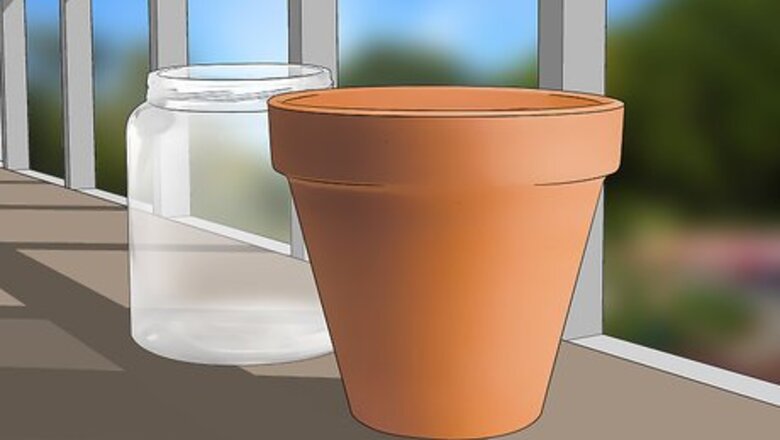
views
Making a Home for Your Caterpillar

Find a large jar or flower pot. Nearly any container can be converted into a great caterpillar home as long as you are able to secure the caterpillar and provide it air holes. Since caterpillars can crawl up the sides, it’s important to have a cover for its home. Otherwise, it’ll crawl away. If you have an aquarium or terrarium that allows air to flow through a lid made of screen netting, then you can use it instead of a jar. Check to make sure that the entire aquarium or terrarium is secure so that your caterpillar won’t escape.
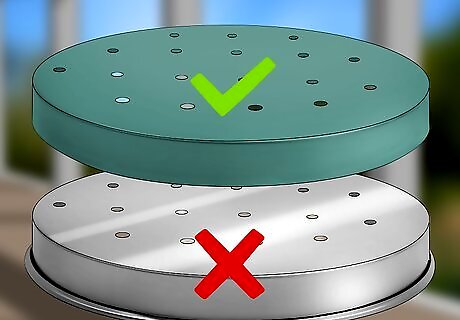
Create a breathable lid. Your caterpillar needs to breathe, so use a porous material like cheesecloth as a lid. Make sure that your cheesecloth doesn’t have holes that are big enough for the caterpillar to crawl through. You can secure the cheesecloth to your jar or pot with a large rubberband. If you don’t have cheesecloth, you can try using plastic wrap with plenty of holes poked in it. Don’t use a metal jar lid because it can harm the caterpillar.
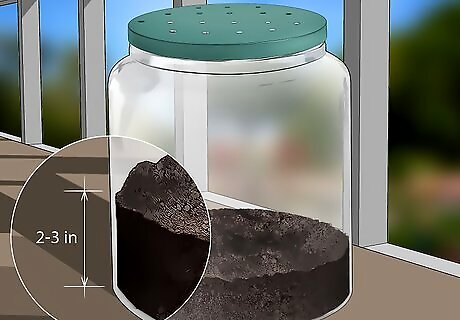
Put a 2-3 inch layer of dirt into your jar or pot. You can use dirt from your yard or generic potting soil. If you find the caterpillar in nature, collect dirt from the area the caterpillar is living. Don’t take dirt from protected land, such as natural parks.

Add grass, twigs, and leaves. Make your caterpillar comfortable by incorporating bits of its natural habitat. Your caterpillar will appreciate having places to crawl and hide. Collect grass, twigs, and leaves from where you found the caterpillar. Do NOT put water into your caterpillar’s home because it will drown.
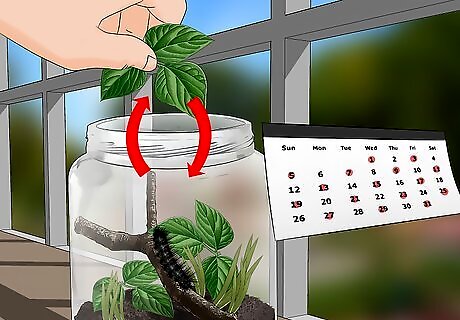
Change out the leaves regularly. You need to change out your caterpillar’s leaves daily or at least every other day because the leaves will decay. If your caterpillar is on the old leaves, put in the new leaves and wait for it to crawl onto the new leaves on its own. Once it’s crawled over to the new leaves, you can remove the old ones.
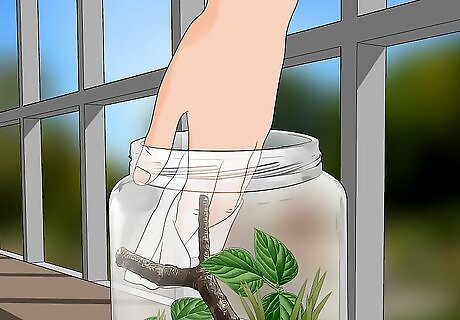
Clean your caterpillar’s home. Caterpillars produce a lot of waste called frass, so you need to clean its home at least once a day to prevent mold or harm to your caterpillar. Use a paper towel to wipe the frass from the cage.

Place your caterpillar’s home outside. If you want to follow your caterpillar’s natural life cycle, the place it on a porch, balcony, or in a garden if you have one. Note that placing a glass jar in full sun on a warm day for even a few minutes can cook your caterpillar, so choose your outdoor location carefully. Keep your caterpillar warm. The caterpillar will hibernate during the winter, so a cold caterpillar will not be as active. If you’re keeping it inside your house, consider putting it on a windowsill.
Feeding Your Caterpillar

Check your yard for caterpillar favorites. If you found your caterpillar outside, start looking there. Caterpillars have a preferred diet, and they won’t switch food sources just because that’s what you give them. If you want your caterpillar to thrive, then you need to find the right plants. Giant leopard moth caterpillars enjoy munching leafy plants like dandelions, violets, honeysuckle, citrus plants, magnolias, lilacs, and broadleaf plantains. If you don’t find the plants in nature, you can buy a small potted plant. Dandelions, violets, and lilacs should be available in pots from your local garden store.

Check carefully for spiders and other insects. Spiders and other insects can prey upon your caterpillar, so make sure that you don’t accidentally put a predator into your new pet’s home. You may come back to find your caterpillar has been eaten.

Place leaves from the plants inside your caterpillar’s home. At first, monitor your caterpillar to make sure that you are feeding it enough leaves. Caterpillars spend most of their time eating, so make sure that you meet your pet’s needs. Feed your caterpillar daily. If you accidentally pull off more leaves than you need, you can keep them fresh by putting them in water and placing the container in the fridge. Remember not to put containers of water in your caterpillar’s home because it will drown.

Add a host plant. If you have enough room in your caterpillar’s home, you can add a live plant for the caterpillar to eat. This is only possible for smaller plants, so look for one that will grow in a small pot, like a dandelion.
Enjoying Your Caterpillar
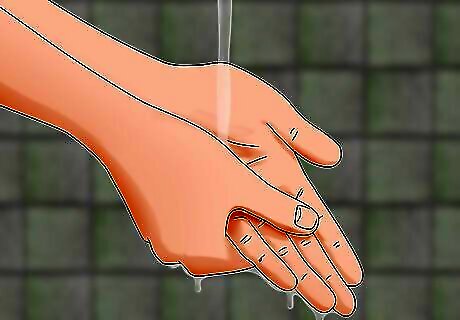
Wash your hands before you touch it. Caterpillars can pick up germs from your hands, so make sure that you are clean before you handle it.

Check on it at night. Giant leopard moth caterpillars are nocturnal, so your caterpillar will be most active at night. You can look for movement during the day, but don’t try to wake up the caterpillar if it’s sleeping.
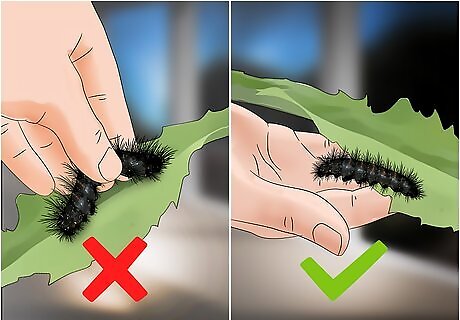
Don’t pull your caterpillar off of a surface. Caterpillars will hold onto what they’re crawling on, so don’t try to remove your crawling critter. It will hold onto the surface and may be hurt.
Helping Your Caterpillar Transform Into a Moth
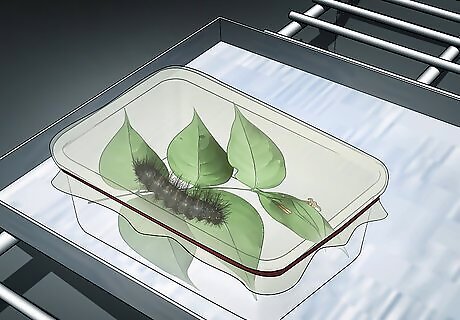
Allow your caterpillar to hibernate. In the wild, giant leopard moth caterpillars hibernate all winter as part of their life cycle. Caterpillars can hibernate outside in their containers all winter, or you can put it into the refrigerator. Don’t freeze your caterpillar. Your caterpillar will not eat while it’s hibernating, but it may be lightly active on warmer days. When it’s mildly active, it might eat available food.

Add more food to your caterpillar’s diet. When your caterpillar wakes up in the spring, it’ll be ready to fatten up in preparation for its metamorphosis into a moth, which will take place later in the spring. Make sure that you provide your caterpillar enough food for it to get ready to turn into a pupa, which is its cocoon-phase.
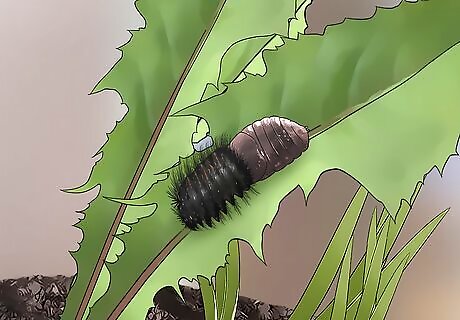
Wait for your caterpillar to shed its exoskeleton. Your caterpillar’s fuzzy skin will slide off once it has fattened up, leaving a smooth black oval called a pupa. This is it’s cocoon phase. You can expect it to shed its exoskeleton during spring.
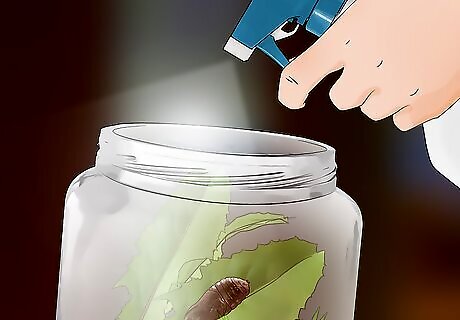
Check the pupa daily. Since you can’t pinpoint the actual date of your moth’s emergence, keep track of its progress each day. While your pupa does not need food, you may want to mist the caterpillar’s home daily to keep it humid. Simply spray a light spritz of water into the container. While their actual time in the pupa can vary, giant leopard moth caterpillars only take a few weeks to metamorphose into a moth.

Watch your giant leopard moth emerge. You can choose to keep your moth or set it free.



















Comments
0 comment